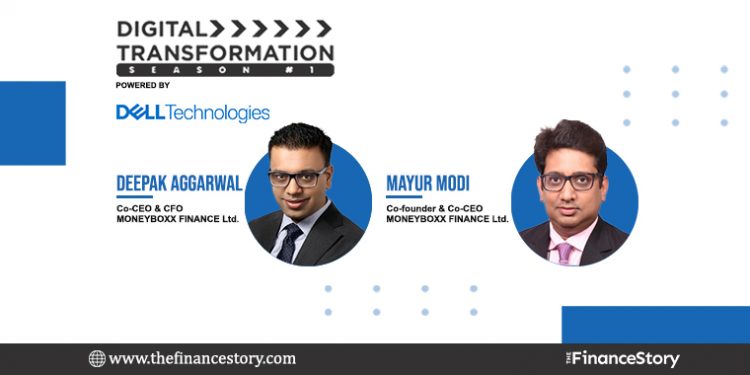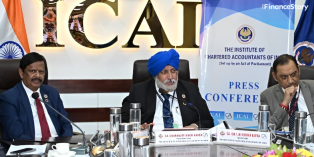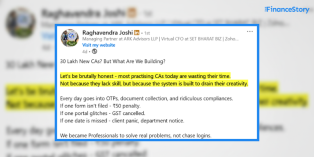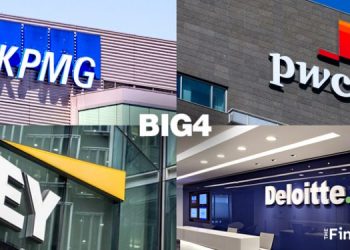- Chartered Accountants by profession, Deepak Aggarwal and Mayur Modi had spent 18 years in the finance industry when they decided to start Moneyboxx – a small-ticket unsecured business loan NBFC in 2018.
- This BSE-listed NBFC though not a fintech is a new-age NBFC that is highly technology-driven.
- As a part of our digital Transformation Series powered by Dell Technologies, we spoke to the two co-founders to understand how they are using technology to break into this difficult segment while maintaining best-in-class asset quality.
Can you tell us a little about yourselves and how MoneyBoxx was born?
Mayur Modi: Deepak and I, both started our careers together and have been in touch even after we joined different organizations.
After working in various roles like corporate finance, equity and debt research, investment banking, and specializing in private equity and debt for larger organizations in 2017, we wanted to establish something that could create an impact while being profitable and scalable to become a large institution. That is when the idea of Moneyboxx was formed – to address the unmet credit needs of deserving micro-enterprises.
Deepak Aggarwal: According to us, bigger institutions always have access to credit, but it is very difficult for small and micro businesses to get a loan especially unsecured loans.
There was a huge gap in this segment and since it is the most underserved category across India; we wanted to explore ways to make credit accessible by moving forward with this business idea. So, with the intention of being an impact lending institution, we started our journey in 2018 with MoneyBoxx contributing an equity capital of Rs 20 crore.
We largely cater to small-ticket unsecured loans from Rs 50,000 to Rs 3,00,000 to micro and small enterprises in mostly Tier II and III cities in India and charge an interest of 27 percent.
Would you classify yourself as a fintech or a classical NBFC?
Deepak: We are not a pure-play Fintech company, though we can be called a new-age NBFC as the origination, assessment, and disbursement is all tech-driven.
Let me explain: Our business primarily depends on rural, semi-rural, or semi-urban borrowers who cannot be expected to download an app and fill in about 350 data points that we collect. Also, these customers do not have formal documents and thus a touch-point is required to assess the creditworthiness.
Therefore, we need a loan relationship officer on the ground to deal with the data collection and ref-checks. This personal touch is also required for the speedy collection of the EMIs. However, excluding the initial stage, everything else is digitized.
So, our business model is not precisely conventional and paper-based since we leverage technology and ensure customer connections through branch presence which also results in extraordinary collection efficiency.
If someone wants a loan, how do they approach you? What is the entire process?
Mayur: We do not depend purely on fintech for the sourcing model. The sourcing model is very different in terms of application.
1. Customer Acquisition
- There is a physical presence in our operating branches, and we hire locals so that we tap local knowledge and provide employment opportunities to locals. These people are accustomed to the ecosystem and are well entrenched in their communities.
- For customer acquisition, our loan officers will visit micro-business owners within a radius of 30-45 km deeper into the rural markets.
2. Thorough Check of creditworthiness
- Our loan officers conduct a thorough check of the customer’s creditworthiness based on the data points collected and our proprietary internal credit assessment models.
- The credit process also involves various types of verification exercises like house verification, business verification, neighbor verification, buyer and supplier verification, and so on.
- All this information is captured in the mobile application.
3. Next step is to present to the central team
- Then it is presented to the central team in the form of structured information for them to take a credit decision
- All our loans are granted for business purposes. If a person is taking out a loan, they have to deploy that money into the business to further generate income. We do not lend for consumption purposes like buying consumer durable, marriage purposes, etc.
4. Disbursement and collection of loans
- Next is the disbursement and collection of loans that are completely digitized, taking place via banking channels like Automated Clearing House Network (ACH).
- The entire life cycle of the loan from processing to disbursal takes about 3-5 days depending on how fast the information is going to the presiding head.
Since technology clearly plays a significant role, can you tell us what various technologies you use currently?
Mayur: Since the business model requires a very strong powerful technological background, we invested in technology infrastructure right from the start.
Contact with the customer is the only physical aspect; other than that, everything is digitalized! Hence, we have created processes and customized applications for the information flow from one to the other.
To give you a perspective:
1. Data analytics is a huge aspect of our credit decision process
- We have integrated various technologies and optimized credit scores and have segmentation-specific insights which we include in our credit scoring models.
- For instance, we cater to four segments: Livestock, Kirana, Trading, and Manufacturing. We gather various insights into every aspect of the customers depending on various segments. Therefore, there is technology involved in every aspect of the process.
2. Processing uses technology and using RPA (Robotic process automation)
- Everything is processed by technology which helps the decision-makers in coming to a decision faster and also removes human biases as much as possible.
- For example, there are only two people managing the whole operation. This is possible because the whole operational flow is automated.
- In the last two years, we have not had a single operational loss. There is no scope for any fraud. We have deployed the best technology available to us.
3. Data connectivity is not very consistent in rural areas.
- We looked into a technology called the SD-WAN technology. This technology consolidates every service provider into a box and adds up the data speed.
- For example, if I have two data providers and add this to the box, it simultaneously doubles the speed. There is never a breakdown of technology in terms of data breakdown. There are zero complaints as there is a backup for data.
4. The whole system is cloud-based including backup and can be accessed from anywhere with no physical servers required.
Tell us more about it.
Deepak: All our systems are interlinked. For instance, the Lending Management System is interlinked with HRMS and Financial Systems.
Mayur: This also ensures data sanctity. If anyone does due diligence and no matter what system they check, everywhere the same data is embedded. We believe that there has to be absolute transparency and sanctity in what is getting reported.
Reputation is paramount in the financial institution business. When lenders do an audit of our processes, they appreciate the number of investments we have made in technology and its results.
What are the technologies you are looking at adopting in the near future?
Mayur: We are now developing better technology to integrate KYC.
If we look at some of our peers, a customer spends one-two hour in a branch to get their loan processed.
In comparison, the only time our customer visits the branch is if their application is finalized and they have to sign loan documents. That is also something we want to eliminate in the foreseeable future and are working on technologies to crunch this time.
The whole experience of taking a loan from us should not be more than fifteen minutes with respect to customers visiting the branch.
Being CAs how do you decide on the right selection of the technology solution for your requirements?
Deepak: Since we are running an NBFC, the most important characteristic is understanding credit and collection well.
Sometimes one ends up focusing too much on technology and that’s what happened to many of the fintech. Many of the fintech in India have double-digit NPA numbers at least in the initial years.
In an unsecured lending business, one needs to thoroughly understand and crack the underwriting and collection processes. When that is very strong, technology can be integrated.
We have a full-time technology team to help us in the selection of IT partners. The most important part is being clear about the end results post which one can automate. We have also always chosen partners who have a proven track record in similar segments.
Today, everything does not need to be done in-house in terms of tech. From hardware to software, we have to make the right choice.
You have a very robust collection system in place almost 95% during the moratorium period. How does technology help in your asset quality?
Deepak: In terms of Non-Performing Asset (NPA), our gross NPA is 0.21 percent of the portfolio which is among the best in the industry. For most fintech, the GNPA is in double digits after COVID.
Last year in FY21, we had to collect INR 28.29 crores in terms of repayments and we collected INR 28.17 crores which is just a difference of 12 lakhs, i.e., 99.6% collection efficiency. As compared to other banks and NBFCs, this would be unheard of in our type of segment.
We have achieved this by keeping a track of 350 data points which is not manually possible. Analytics help a lot in the technological domain.
Mayur: For example, two-thirds of our portfolios are in livestock. A lot of data points are integrated into our system about customer behavior, lifestyle, other sources of income, and so on.
With the amalgamation of all these points of over 5000 customers, we are able to determine the typical income of the people and standardize our scoring system.
Based on the above, we can evaluate an application and accordingly grant a loan.
Here, technology, or specifically, data analytics plays a role.
It also serves to widen our customer base. Once we have these data points and we know that these points match. If a potential customer comes and displays some of these characteristics, we do not shy away from lending to them.
20% of our lending consists of people who have never taken a loan in their lifetime. We are bringing first-timers into the economy which is a huge achievement.
They are eventually going to grow and avail multiple financial products both insurance and investment products and we would be ready to serve them. It is important to bring as many people as possible into the formal economy.
If we have data points that can corroborate our thesis, we are able to make a credit call and then lend it to him. Most of our new credit borrowers have repaid the money back. They are very conscious of paying us back to maintain a good credit score.
What does the cloud mean to your organization?
During the pandemic, we were not worried about our operation since everything is on the cloud and there are no physical servers. We did not want to invest unnecessarily capital expenditure in deploying huge servers.
We use a SAAS model for our IT software and hardware requirements. With SAAS, there is no upfront CAPEX and always avail of the latest technology.
What sort of balance did you try to bring in, just to remain cost-conscious/ effective in the solution?
Mayur: We have a 5-year technology budget in place. A concise cost-benefit analysis is done for any business endeavor.
The team has come up with interesting ideas for implementation. That is how we get the confidence to try out new technologies. We believe that the more we spend judiciously on technology, it will only help us grow the business in the long run.
Lastly, can you tell us where you see emerging technologies being of use in this space?
Mayur: As we grow, we are constantly pursuing technologies or solutions which can help us better analyze the data points and make a quicker decision.
We keep stumbling across various technologies and sometimes they turn out nascent. However, we do not refrain from investing money in technological prospects. If there is a new technology available, we can just plug it into our systems and everything gets automatically integrated.
For example, we have tried a technology that helps us to click a picture of the cattle and if we visit the same customer after one month, the software is able to detect whether it is the same cattle or not.
Machine learning keeps on evolving.
There are various technologies evolving to avoid fraud and there are prototypes available today.
Deepak: Another area of development is in the co-lending model.
A lot of NBFCs can work with banks to generate a proper portfolio. Banks cannot have a niche in every area. There are many other areas where the NBFCs can generate the portfolio much more efficiently. Even the market is missing those kinds of solutions.
Now It’s Your Turn…
What does technology mean to your business?














